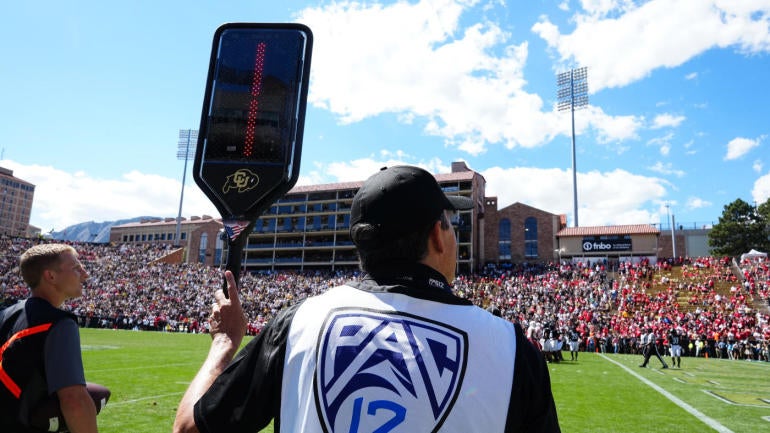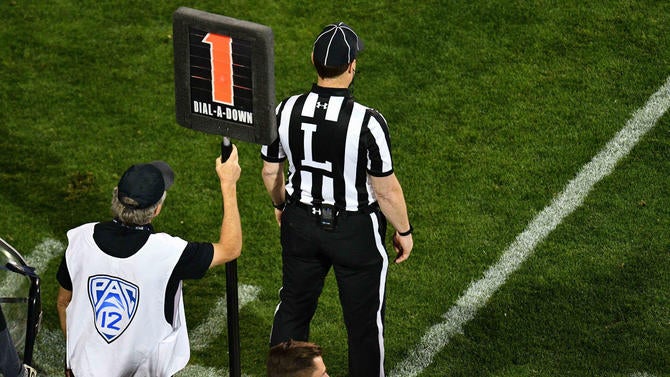
Last year a group of four FBS conference commissioners were very quietly assigned by their peers to dig deep on a concept to essentially prepare the game to move to a 12 team College Football Playoff.
They would look seriously at cutting down on the number of plays. Similar attempts over the years had proven uneven. In 2006, rule changes sliced an average of 13 plays off each game. Those changes lasted a season.
Ten years later there were serious discussions about eliminating kickoffs. The idea was never adopted.
The mission remained the same as that subcommittee of the 10 FBS conference commissioners – aided by two offensive coordinators and two football administrators – zeroed in on a concept. There had to be a meaningful way to cut plays out of each contest without critically impacting the game.
Less football meant less injuries. Less injuries meant less litigation. Less litigation meant an expanded playoff was easier to sell to, well, everyone.
What seemed like a controversial idea was finalized in the offseason – let the clock run on first-down plays that ended in-bounds. Same as the NFL, except for the final two minutes of each half.
Tradition dies hard in college football. The clock had stopped on first down in the sport since 1968. Some coaches immediately howled that the number of plays would decrease.
They were largely wrong. Through four games – one-third of the regular season – there is now a representative sample from which to draw conclusions. With the new timing rule for first downs, the game remains largely unchanged. Compared to the numbers after four weeks in 2022, there are an average of 5.34 less plays per game.
"Very little," LSU's Brian Kelly said this week of the new rules' impact on the game.
But there is a larger story because of that subcommittee and the commissioners' overall intent. The NCAA spends at least $10 million per year defending lawsuits related to FBS issues, many of them dealing with injuries and medical concerns.
Since the beginning of this century, more than 30 college football players have died. The overwhelming majority of those deaths were in the offseason. Before an expanded playoff could fly, with some teams playing up to four extra games, college football had to be made safe.
"You're the first to figure it out," said one of those commissioners who did not want to be identified.
"Definitely," another commissioner said, "We knew the rule changes would shorten games and reduce plays, reducing in-season wear and tear, especially for the playoff teams. This has been a concern for a long time."
There were already other concerns regarding players opting out of smaller bowl games. If injuries become an issue in a playoff that could add four extra games – the equivalent of an extra one-third of a season – would that force some star players heading to the NFL Draft to sit out the CFP? They would conceivably be forced to make a choice between life-changing first-round money and chasing a College Football Playoff championship that pays nothing?
"They scenario-plan everything," said Tom McMillen, head of Lead1 the FBS ADs organization. "They're an event business. I asked Bill Hancock [CFP executive director], 'Have you scenario-planned that?' He said they hadn't. They talked about it but they never scenario-planned it."

Now the question becomes – are the commissioners done tinkering with the game? Usually rule changes bubble up from the NCAA Football Oversight Committee or via recommendations from the American Football Coaches Association.
This came from the commissioners with an agenda.
Multiplied over 12 regular-season games the current reduction in plays would equal roughly the equivalent of one less game's worth of offensive snaps (64.08 plays). Before the rule change, a detailed rules committee study counted not only snaps but included penalties, kickoffs, extra points and two-point conversions. They were called total "exposures".
Last year's average of 179.34 exposures per game were almost 25 more than NFL players face. Opinions began to be formed.
"You look at NFL games, they average 155 plays versus our 179. People look at that, and say, 'Does that make any sense?' " said Steve Shaw, secretary-editor of the NCAA Rules Committee. " 'Our kids are going to class. Our kids are doing other things. The pros are doing nothing but playing football.' "
Numbers tend to flatten out as conference play begins. So the current difference of 5.34 plays may be even fewer by the end of the season.
Year over year, games are five minutes shorter – to an average of 3 hours, 16 minutes through four weeks – but that wasn't a primary intent of the rule change. Claims of time saved being dedicated to shoehorn in more TV commercials have been shot down.
This season's other rules changes haven't been as controversial. Teams can't call multiple time outs during one stoppage to freeze a kicker. Only the second and fourth quarters are being extended to accommodate an untimed down due to a penalty, inadvertent whistle or offsetting penalties.
A further radical consideration was rejected early – allowing the clock to run after incomplete passes. But it's interesting to note there was enough information parsed to determine games would lose an average of 17 plays per game.
"The deviation per game was wild and varied," Shaw said. "What we did with the first down, it was pretty tight. Each game looked pretty similar. When we looked at the incomplete pass, it was a lot broader and a lot of wild swings."
Anything to sell what will immediately become the longest season in FBS history. FCS teams have had a playoff for decades but those teams usually play only 10 regular-season games. When the 12-team College Football Playoff was first mentioned in June 2021, it was explained that part of the selling point to the presidents was that only a small fraction of teams would only play four additional games.
In fact, those 11 playoff games divided by 12 teams equals an average of only .917 additional games per team.
It will be more complicated than that, but the change to the first-down rule helps diffuse talk about eliminating conference championship games in the name of player safety. As those games become less relevant in the expanded playoff, they still are a key source of revenue in conference media rights deals.
So, yes, money matters too. The expanded playoff must be buttoned-up with the new format's TV rights about to go out to bid. The current contract ends after the 2025 season.
The game has seemed to flow at a normal pace without there being a distraction. Taken as a whole, the rule change has "worked" – at least for some – and has had a minimal negative impact.
"There is no need. The game is fine," Ole Miss coach Lane Kiffin said. "Why were we shortening the game? If you look at that from an analytic perspective, you're shortening the game down and creating less impact plays for a team or impact players."
Kiffin was highly critical of the rule change, but the Rebels still managed to score 73 points against Mercer in Week 1.
"I know Lane Kiffin made that comment," Shaw said in jest. "I would never go into a war of words with him because you're going to lose. What my answer back to him would have been, 'You scored 73 points. Just how many more plays did you need to pummel [somebody]?' "
Overall, coaches have mostly adapted. Anecdotally, some have noticed an impact on the number of possessions. Scoring is slightly down five weeks in – a combined 53.8 points per game compared to 54.7 all of last season.
South Florida's Alex Golesh might be the best example of the first-down rule's minimal impact. Golesh brought his up-tempo offense from Tennessee and successfully instituted it for the Bulls, who are running a stunning 17 more plays per game (80 as opposed to 63) than they did in 2022.
However, South Florida's offensive pace is about the same compared to what Golesh ran at Tennessee. Last season, with Golesh as offensive coordinator, the Vols averaged an impressive 2.88 plays per minute. Factor in the time of possession and Tennessee averaged a snap every 20.9 seconds. That's definitely fast.
At USF that number is 2.79 plays per minute or a snap every 21.9 seconds.
"It stands to reason that you'll have fewer possessions …," Golesh said. "The saving of timeouts at the end of the game, that is what has become more critical. I think not wasting timeouts is probably the main thing I've gotten out of the new clock rule more than anything else.
"The games seem to be about the same length … The bottom line is the value of possessions has gone up because there are fewer of them."
With scrutiny coming from all sides, does Shaw expect the coaches' howling to die down?
"Not really," he said. "I'm not sure it will."
Time marches on
The impact on college football through the first four weeks of the season after a change to the rule that keeps the clock rolling after a first down except in the last two minutes of each half.
| | 2022 (Full season) | 2022 (Through Week 4) | 2023 (Through Week 4) |
|---|---|---|---|
| FBS total exposures per game | 179.34 | 181.39 | 176.05 |
| Game duration average | 3:21 | 3:21 | 3:16 |
| Scoring average per game | 54.7 | 56.4 | 53.8 |
| Pct. of games longer than 3:30 | 21.8% | 22.8% | 13.1% |





















